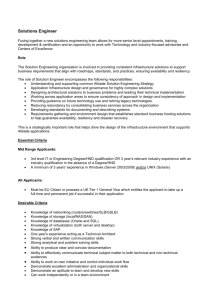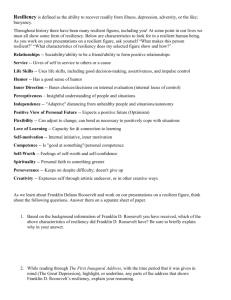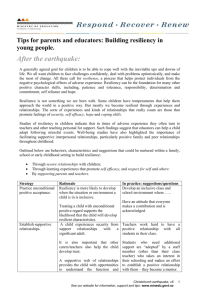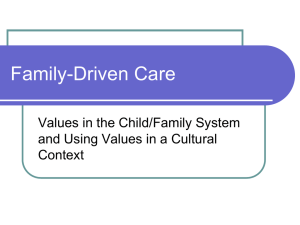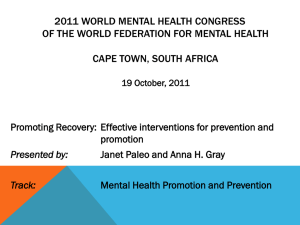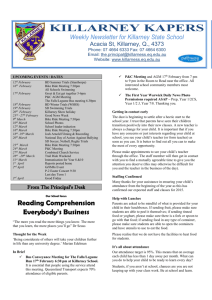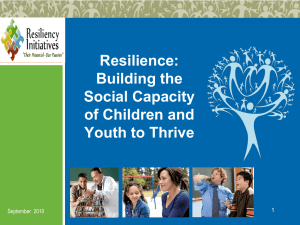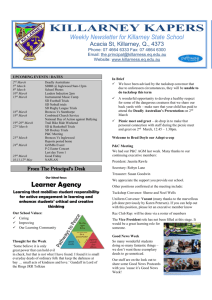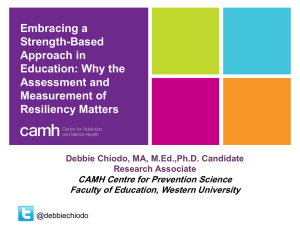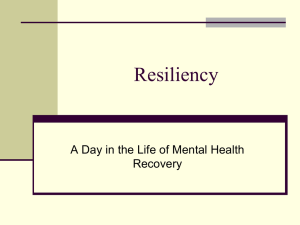school plan - Vancouver School Board
advertisement
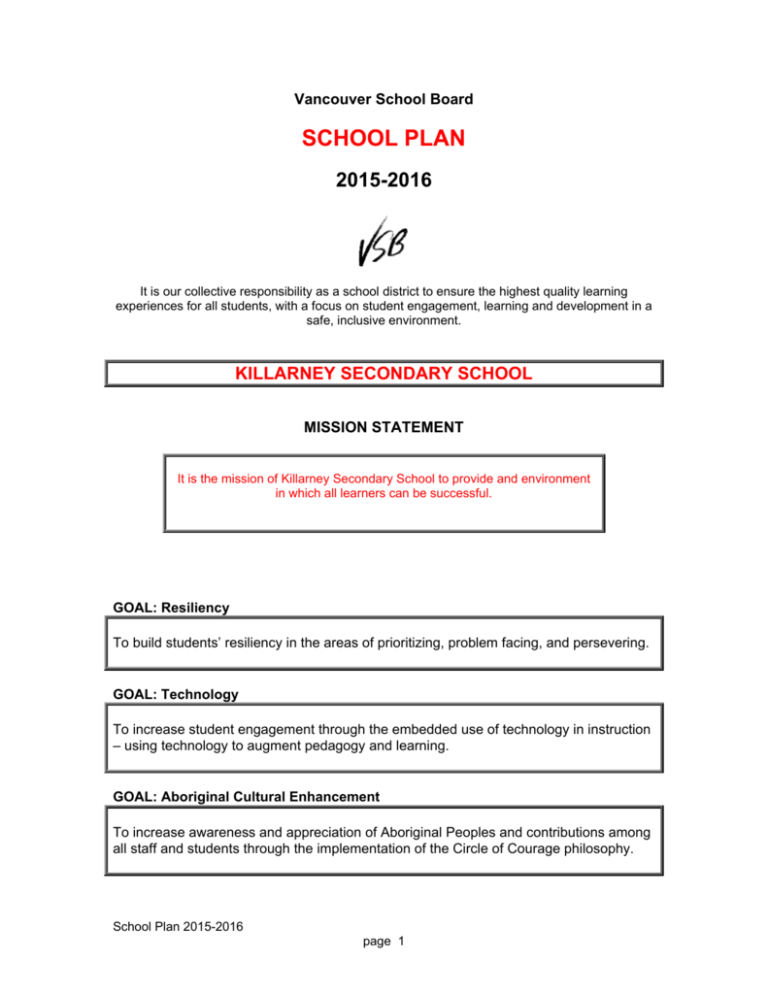
Vancouver School Board SCHOOL PLAN 2015-2016 It is our collective responsibility as a school district to ensure the highest quality learning experiences for all students, with a focus on student engagement, learning and development in a safe, inclusive environment. KILLARNEY SECONDARY SCHOOL MISSION STATEMENT It is the mission of Killarney Secondary School to provide and environment in which all learners can be successful. GOAL: Resiliency To build students’ resiliency in the areas of prioritizing, problem facing, and persevering. GOAL: Technology To increase student engagement through the embedded use of technology in instruction – using technology to augment pedagogy and learning. GOAL: Aboriginal Cultural Enhancement To increase awareness and appreciation of Aboriginal Peoples and contributions among all staff and students through the implementation of the Circle of Courage philosophy. School Plan 2015-2016 page 1 School Plan 2015-2016 page 2 SCHOOL COMMUNITY CONTEXT What are the demographics of our learning community? Who are our learners? What is our vision of success for learning for each student? In 1957, the area to the south and east of the school was just beginning to be developed and so the school was surrounded by vacant land. As the area south of 49th Avenue was developed and grew, so did Killarney. In November 1961, B wing was completed and opened. Six years later, in December 1967, D wing opened which greatly expanded and improved the Science and Technical Studies facilities. Killarney’s school population steadily grew in the 1970’s and 1980’s and thus by the 1990’s there were 11 portables on site. As a result, in March 2002, a further 20 classroom addition was completed including more science facilities, a state-of-the-art music facility and a new office area. In the late spring of 2010 the Vancouver School board moved three alternate education programs under the “umbrella” of Killarney Secondary. These programs have grown and stabilized over the past four years, in both number of students and number of graduates. Spectrum Alternate (Grade 10, 11, 12) (120 students) Foundations (Grade 8, 9) (22 students) West (Grade 9, 10) (22 students) The projected population of Killarney for 2015-2016 is 1935 students with approximately 165 teaching and non-teaching staff members. Our community of learners is 60% from homes where English is not the primary language although only 5% of our students are enrolled in ELL classes; 2% are Aboriginal learners; and 11% are Special Education learners. Additionally, 52% of the population is male students, while our families are 18% single parent and 29% report an annual income under $30,000. Killarney Secondary is proud to be the host school of the district Visually Impaired Program. The school offers a comprehensive program of studies for students with diverse learning needs. We offer remedial programs and enrichment programs; an extensive fine arts program; and a large, comprehensive and successful athletics program. Killarney students, graduates, staff and parents have developed many traditions and take pride in the history and accomplishments of our community. Our vision of success for learning is for all students to reach their full potential and to foster life-long learning. Aspects of life at Killarney have been built around the various cornerstones, which are: School Motto: School Colours: School Emblem: Team Name: ‘Semper Fidelis’ (Always Faithful) Green and Grey Shamrock Cougars School Plan 2015-2016 page 3 REFLECTIONS ON 2014-2015 SCHOOL PLAN What was our goal? What steps did we take to address the identified student(s) needs? What was the evidence of success for each student? How did we communicate and celebrate student success? GOAL #1: Building students’ resiliency in the areas of prioritizing, problem facing, and persevering. Objectives: Modeling the Circle of Courage: Belonging, Independence, Mastery, and Generosity. 1) Develop a sense of belonging and community connection (Belonging) 2) Foster independence through self-awareness and self-actualization (Independence) 3) Empower students to take ownership for their learning (Mastery) 4) Foster social responsibility within the school community (Generosity) Steps taken to address the identified student(s) needs: October 2014 – Killarney Mental Health Cohort (SRT, Counselor, Administrator, and Teacher Leader) trained at UBC in the Mental Health curriculum by Dr. Kushner. Attended Anxiety BC workshop: Strategies and Resources for Helping Anxious Youth. Curriculum implemented through Planning 10 classes. October 2014 - Mental Health Symposium (BCPVPA) attended by Admin– workshops Belonging and Connectedness and Canadian Self-Regulation Initiative. October – VASSA Conference highlights – you increase passion in staff by increasing their skills (capacity). November 2014 - Math Department hosted Hour of Code – exercising persistence and risk taking. November 2014 – Staff meeting – staff reflected and reported out what they do to connect with their students referencing Google Doc created in 2013 (What are you doing to help students feel connected?). Some feedback included: Always smile and say hi to them in the hallways Positive affirmations activity once every few weeks I ask students about their lives and take any opportunity to make a connection If a student has been missing my class, I often let them know that I miss them in class and look forward to their return When on supervision, I get to know the “pods” of students sitting together by asking them questions November 2014 – ELL Department + UBC Study (researcher: Monique Gagne – Risk and Resilience in new young Canadians – looking at protective factors in their lives that lead to positive academic and social emotional competence as it relates to positive adaptation and development. November 2014 – PBIS team (Youth and Family Worker, 4 teachers, Counselor, and Administrator) undertook training reinforcing pro-social behaviour – to provide students with the skills, coping strategies, and desire to deal with the frustration that is an inevitable part of life. November 2014 – PDK lecture (Building Community in a Time of Change) School Plan 2015-2016 page 4 attended by teachers and administrators. January 2015 – School-wide Pro D on January 19, 2015 led by Counselling team. Topics covered include: How resiliency happens What can we do an what are we doing in our work with young people The most important steps to take in fostering resiliency How to overcome the greatest barrier to fostering resiliency The Resiliency Wheel Six factors of resiliency identified and departments worked to identify how they specifically address each factor. Topic covered at department meetings later in the Spring to identify areas of possible growth or improvement. Results from data collection attached in Appendix B February 2015 – Student Forum. Killarney Student Forum Leaders asked a random selection of students – “What are some of the things that make you feel connected to your school?” The responses were collected, collated and a WORDLE was created to expand the conversation. School Plan 2015-2016 page 5 March 2015 – WORDLE shirts worn by all participants of the Student Forum. Participating students were called upon by teachers to explain the Student Forum process and what the WORDLE means to Killarney. WORDLE laminated posters were distributed school-wide and posted in every classroom. March 2015 – Student Satisfaction Survey continued with the use of Resiliency Committee questions created in 2013 to survey student cohort graduating June 2018. April 2015 – Student Satisfaction Survey questions for cohort students analyzed for areas of growth in resilience. Results attached in Appendix A Ongoing – vulnerable students connected with resources within the community (Boys Club, CART, Mental Health Resources, and SACY). Continuation of the PBIS training and implementation of practices. What was the evidence of success for each student? Attendance monitored to identify students most at-risk. Opportunities to connect with counsellors and administrators including direct teaching of Stephen Covey’s Seven Habits of Highly Effective Teens. Through Student Forum participation, students were able to identify ways in which they currently demonstrate resiliency: Student Satisfaction Survey results (Resiliency Committee + D. Buote specific questions added to the survey as attached and compared to baseline data) Building on the Google Doc created in 2013 the Student Forum allowed students to continue to examine areas of connectedness and their perceptions of how Killarney supports factors of resiliency: Provide Opportunities for Meaningful Participation; Increase Pro-Social Bonding; Set Clear Consistent Boundaries; Provide Caring and Support; Teach Life Skills; and Set and Communicate High Expectations. School Plan 2015-2016 page 6 How did we communicate and celebrate student success? Grade 12 student’s Independent Studies project – Killarney Green Board (a moveable green cube that acts as a suggestion box, sounding board, and information gathering device) used to garner feedback from students and announce results. Classroom and Department Head discussions, staff meetings, collaborative time. School and parent newsletters, PAC meetings, Facebook, Twitter Principal recognition letters, teacher phone calls home, interim reports “Go Green” cards given by staff to staff and students showing improved or evidence of resiliency. Prominently posted resiliency quotes on outdoor school sign and school website Student grade assemblies, and Honour Roll recognition assemblies, Principal’s Recognition letter, meetings, and phone calls home. Graduation ceremony Verbal acknowledgement (ongoing) On – going celebrations of success (for example ice cream awards for most improved students, providing Teachers with the opportunity to honour the success of all their students) Student – Administration – Teacher – Counselor – Ongoing conferences between student and teacher, student and counselor, student and administrator Random drop in by Administration team to deliver small rewards (for example hot chocolate cart) to all students. GOAL #2: To increase student engagement through the embedded use of technology in instruction – using technology to augment instruction and learning. YEAR 2 (a) Technology resources and multimedia tools purchased and distributed school-wide. Each teacher on staff received a device (Apple MacBook Air or Microsoft Surface tablet.) (b) Continue to invite staff to participate at informal / drop-in “Tech Tuesdays” demo / exploratory sessions (run by teacher-librarians and tech-savvy students). (c) Teacher-librarians, in consultation with VP overseeing CS students, will organize “Geek Squad” CS students. The Geek Squad will operate out of the Library Learning Commons with students reporting to TLs who oversee their schedule and monitor their employability skills. (d) Administrators modeled the use of technology at staff meetings (Google Docs, Skype, and Google Hangouts. (e) Pro D – John Tyler (Principal Spectrum School – Victoria B.C.) presented “Using Technology to Re-engage the Disengaged Learner” to Killarney teaching staff. His emphasis is on how to use technology to facilitate selfdirected learning. The ‘takeaway’ from the session was to help teachers to become more comfortable using technology in their classrooms so that the experience is more beneficial to both them and their students. School Plan 2015-2016 page 7 (f) PDK Session (April 22, 2015) attended by teachers and administrators – The Transformationality of Technology (Jordan Tinney and George Couros). Technology will never replace great teachers, but technology in the hands of great teachers can be transformational. (g) Pro D – May 2015 Admin Pro D that built on the feedback from staff gathered at the April Pro D to access teachers who are already using technology to assist in the use of specific apps or programs for other teachers, allow opportunities for exploration + experimentation using students as experts, provide support to allow risk taking to occur. Staff worked with fair chance learning, district staff, and Killarney teachers and students. Objectives: 1) Build on teachers’ use of and familiarity with incorporating technology into subject areas 2) Increase student engagement by incorporating additional technology resources and multimedia tools in classrooms. (i.e. learning from students through using classroom apps, collecting feedback from students about the use of technology in different classrooms, giving students the option of creating final presentations in formats beyond PowerPoint (Prezi, Glogs, Thinglink) 3) Continue to provide opportunities for guided use of Web 2.0 tools and student devices during instructional time. Continue to allow students to demonstrate new Web 2.0 tools to the class. Steps taken to address the identified student(s) needs: Departments used at least one collaborative time or Pro D session for exploring technology exploration and invite other departments to attend Acknowledged student voice in recognition of innovative technology use by individual teachers (early adopters) Consulted with District Consultants, Tech Mentors, and our teacher-librarians Staff explored one tech-related strategy that can be used in daily practice (e.g. think, pair, share, and tweet it to a friend!) Involved students as experts especially “Geek Squad” CS students) Consulted with District Consultants, Tech Mentors, and our teacher librarians Evidence of success for each student: The adoption of document cameras by several departments Increased use of mini ipads and other bookable portable devices Increased use of BYOD (Bring Your Own Device) in the classroom Use of Wi-Fi school-wide Desire by students to submit homework and access teachers online How did we communicate and celebrate student success? Through classroom and Department Head discussions, staff meetings, collaborative time, principal recognition letters, teacher phone calls home, interim reports, School Newsletter, prominently posted reading quotes on the outdoor school sign, Facebook, Twitter, PAC meetings, Parent Newsletters and, links on school website featuring School Plan 2015-2016 page 8 recommended book lists and reading strategies. With Student grade assemblies, and Honour Roll recognition assemblies, Newsletters and updates, Facebook and Twitter announcements, highlighted school sign displays, Principal’s Recognition letter, meetings and phone calls home; and “Go Green” cards. Verbal acknowledgement of technology use by students and staff, e.g. Gather and share anecdotal feedback from staff and students re: technology usage and pedagogical value Remembrance Day Assembly showcasing student work with technology to connect students to the significance of the day Acknowledgement and appreciation for “Geek Squad” CS students Showcase select technology demonstrations (by staff and/or students) in the Library Learning Commons and cafeteria during collaborative time, beginning of Pro D days, etc. Student / staff technology demonstrations at PAC meetings and Staff Meetings School Plan 2015-2016 page 9 2015-2016 SCHOOL PLAN Based on our assessments and evidence, we are adjusting and refocusing our School Plan to continue to address the needs of the identified learners by: GOAL: To build students’ resiliency in the areas of prioritizing, problem facing, and persevering. Objectives: Modeling the Circle of Courage: Belonging, Independence, Mastery, and Generosity. 1) Develop a sense of belonging and community connection (Belonging) 2) Foster independence through self-awareness and self-actualization (Independence) 3) Empower students to take ownership for their learning (Mastery) 4) Foster social responsibility within the school community (Generosity) What steps are we planning to address the needs of the identified learners, including our Aboriginal learners? i.e. What strategies and structures do we believe will lead to student success? This is our third year of this goal. 1. Continue to survey Grade 8 – Grade 10 students using the Satisfaction Survey from the Ministry of Education and provide the feedback derived from the eleven questions created by the Killarney Resiliency Team + D. Boute to the staff 2. Continue to build on staff awareness through Pro D workshops (some staff led) 3. Re-introduce Collaborative Day discussions through the book club format – including a literature review 4. Continue to build awareness of student resiliency through direct curriculum, newsletters, and assemblies 5. Ensure student input and voice by continuing to hold student forums twice a year and connect student forums to the Student Government 6. Encourage staff within department to work on their identified areas of The Resiliency Wheel. 7. Continue to provide scholarship access to those students who have overcome adversity and have attained a high level of success in a program, but will not obtain a Dogwood Certificate 8. Teachers and staff promote life-long learning in order to encourage students to be more well-rounded and to develop stress-releasing, passionate interests. What will be our assessments and evidence of student success? Track report card grades (term by term/three terms per year) of identified grade eight students (Cohort, English classes) to monitor student learning in connection with resiliency education Monitor attendance and punctuality in classes to identify students most at risk (for example students who qualify for Administrative Support Time) and provide opportunities for students to connect with Administrators Use Student Satisfaction Survey results from highlighted specific questions (created by the Resiliency Committee and D. Boute) to continue building the trend line – attached School Plan 2015-2016 page 10 (2014 – 2017) Bi-monthly Grade meetings with Counselors, Aboriginal Enhancement Worker, and appropriate Grade Administrator to discuss identified At-Risk students and review progress Administrators, Counsellors, and Teachers track academic and work habit results of identified at-risk students and monitoring student performance in courses Counsellors anecdotally report less stressed out students (based on their bookings). Based on our assessments and evidence, how do we plan to monitor, reflect on and adjust, where necessary, our impact on the learning of each student(s)? Feedback from Student Forums and Student Satisfaction Surveys is shared with staff and students to establish an awareness of where we are currently. Going forward, students will use their expanded knowledge to build on their goals. Reflecting on the results of the Student Satisfaction Survey and the feedback from the Student Forum has led to our focus on creating opportunities to build connectedness between staff and students. How will we communicate and celebrate student success? Moodle Posters and Shirts – increase visibility school-wide from screen savers to mugs and hallway banners Newsletter PAC Meetings Assemblies How will we engage all members of the school community to ensure sustainability of student success? Keep it in the foreground – as an active part of each Staff/Department Head Meeting Routine visits to classes by Administrators to celebrate success Continue to work with PAC to provide information sessions in the evening for parents/guardians Based on our assessments and evidence, we are adjusting and refocusing our School Plan to continue to address the needs of the identified learners by: School Plan 2015-2016 page 11 GOAL: To increase student engagement through the embedded use of technology in instruction – using technology to augment pedagogy and learning Objectives 1) Incorporate technology into teachers’ subject areas and increase teachers’ ‘comfort levels’ with the newly acquired devices (Microsoft Surface tablets and MacBook Air computers) 2) Increase student engagement by incorporating additional technology resources and multimedia tools in classrooms 3) Provide support for teachers to take risks with using new technology 4) Provide more opportunities for guided use of Web 2.0 tools and student devices during instructional time. What steps are we planning to address the needs of the identified learners, including our aboriginal learners? i.e. What strategies and structures do we believe will lead to student success? Show teachers different ways to begin incorporating technology - use data to illustrate how technology can transform the learning space and better prepare students for their future. Allow for the difference in ‘comfort’ levels and learning curves – each person will work at his or her own pace. Continue to provide ‘training opportunities’ for teachers – led by industry experts, teachers on staff, and in some cases, students. Departments use at least one Collaborative morning or Pro D session for technology exploration and invite other departments to attend Consult with District staff and Tech Mentors Continue to develop the Killarney Learning Commons with our teacher-librarians Trained educational professionals are needed every step of the way to help students discern and filter through technology and to be critical users of technology What will be our assessments and evidence of student success? As more teachers are increasing the use of technology in their classrooms, use a digital format (digital display board) to showcase and make student learning visible. As the momentum continues to increase, there is an increased demand to have teachers share ‘tips and knowledge’ about what is working in their classrooms. Increased student engagement evidenced by increased attendance and punctuality, as well as formal surveys from students. More technology use in classrooms and assemblies – information gathered through staff and student surveys. School Plan 2015-2016 page 12 Based on our assessments and evidence, how do we plan to monitor, reflect on and adjust, where necessary, our impact on the learning of each student(s)? Feedback from student and staff (i.e., Google Doc surveys and informal, anecdotal feedback) Monitor and track usage of peripheral technology (projectors, document cameras, Apple TVs, etc.) Reflect on and adjust to achieve increased engagement at all levels The Geek Squad will report to and be monitored by the teacher-librarians. Anecdotal feedback and a formal survey mid-year and year end will be gathered from the Geek Squad regarding the use of technology and pedagogical value. How will we communicate and celebrate student success? Through classroom and Department Head discussions, staff meetings, collaborative time, principal recognition letters, teacher phone calls home, interim reports, School Newsletter, prominently posted reading quotes on the outdoor school sign, Facebook, Twitter, PAC meetings, Parent Newsletters and, links on school website featuring recommended book lists and reading strategies. With Student grade assemblies, and Honour Roll recognition assemblies, Newsletters and updates, Facebook and Twitter announcements, highlighted school sign displays, Principal’s Recognition letter, meetings and phone calls home; and “Go Green” cards. Graduation ceremony Verbal acknowledgements (ongoing) How will we engage all members of the school community to ensure sustainability of student success? Verbal acknowledgement of technology use by students and staff, e.g. Gather and share anecdotal feedback from staff and students re: technology usage and pedagogical value Acknowledgement and appreciate for “Geek Squad” CS students Showcase select technology demonstrations (by staff and/or students) in the Library Learning Commons and cafeteria during collaborative time, beginning of Pro D days, etc. Student / staff technology demonstrations at PAC meetings GOAL: Aboriginal Cultural Enhancement School Plan 2015-2016 page 13 To increase awareness and appreciation of Aboriginal peoples and contributions among all staff and students through the implementation of the Circle of Courage philosophy. Objectives: Based on our assessments and evidence, we are adjusting and refocusing our School Plan to continue to address this goal by: Reflections on Current Practice, 2015-2016 What steps did we take that built knowledge, awareness, appreciation of, and respect for Aboriginal histories, traditions and cultures among all students? What data are we using to guide and adjust our practices? We have based our school growth plan goals on the First Nations’ Circle of Courage to provide a solid foundation that enhances a culture of success. The Circle of Courage philosophy focuses on developing the whole person and creating a strong sense of community as evidenced by theses four inextricably intertwined pillars: Belonging: Is a significant sense of community, of welcoming and caring for others, and of being cared about. Independence: Is the power to make choices and be responsible for them, set personal goals, and establish and strengthen self-discipline. Mastery: Is being competent and striving to achieve our personal best. Generosity: Is caring and finding purpose beyond oneself be offering. All our school goals have been organized around these four pillars. Additionally, our Transitions Teacher (G. Kent) will be working with the parents of our Aboriginal students in the creation of the Student Success Plans to increase feelings of connection for both students and parents. We will continue to host the Aboriginal Cultural event each Fall and Spring in our library that brings students from our school to foster community and support. School Plan 2015-2016 page 14 Killarney Secondary School Submitted by School Planning Council (name) (Signature) Principal _____Roberto Moro________ ______________________ Teacher ______Mary Peters_______ ______________________ Teacher _____Gesa von Keyserlingk ___ ______________________ Parent ______ Arlene Vanderhoven _ ______________________ Parent ________________________ ______________________ Student _____Sun Woo Baik________ ______________________ Date _______June 1, 2015_______ Recommended Approval by Superintendent _______________________ (Superintendent) Date ______________________ (Signature) ______________________ Board Approval ______________________ (Board Chair) Date ______________________ School Plan 2015-2016 page 15 ______________________ (Signature) Appendix A Killarney)Satisfaction)Survey)Questions)3)Resiliency) Grad)2018)Cohort)Responses:)Ques? on)1) Grad)2018)Cohort)Responses:)Ques? on)2) School Plan 2015-2016 page 16 Appendix B Whatdowedotoindentifyourstudents' 1‐Relationships strengths? (25%) 2‐Service(5%) 3‐LifeSkills(12%) 4‐Humour(2%) 5‐InnerDirection (4%) 6‐Perceptiveness (1%) 9% 0% 4% 7‐Independence 25% 10% 8‐Positiveviewof personalfuture(1%) 5% 12% 12% 5% 5% 4% 2% 1% 1% 4% 2% 9‐Flexibility(2%0 10‐Loveoflearning (5%) 11‐Self‐Motivation (5%) 12‐Competence (12%) 13‐Self‐Worth (10%) 14‐Spirituality(0%) 15‐Perseverance (4%) 16‐Creativity(9%) School Plan 2015-2016 page 17 RESILIENCY: MODERN LANGUAGES PROVIDE CARING AND SUPPORT: As a dept. we need to improve in the above area by: Accommodating to all students (not just the weak and strong but also the mid-range) Being more flexible with due-dates and time-lines Accommodating individual learning styles, for example, giving more choices in terms of project formats, ie: allowing students to use Prezi instead of an actual paper poster Focusing on individual student strengths outside of the classroom; being aware of their outside interests and hobbies and providing opportunities to discuss these in class and incorporating them into course content and unit themes. Celebrating and recognizing student victories outside of the classroom, ie congratulating a student for scoring a goal in a game in front of whole class. Making more comments to individual students in terms of acknowledgement of improvement and progress in achievement, work habits, attendance and participation. RESILIENCY: SCIENCE DEPARTMENT SET AND COMMUNICATE HIGH EXPECTATIONS: Work to the Best of Your Ability Classroom routines and procedures are clearly outlined so students know what to expect Rubrics for projects so clear so students know what is expected of them As a review or preview of a test or lab, using anonymous student exemplars to demonstrate high quality answers. Showing examples of past student work After a test or lab, review areas/concepts/questions that are poorly done. Speaking with students that are not succeeding and try to come up with strategies for success with the student. For example review study and work habits to see if they are being inefficient. School Plan 2015-2016 page 18
